You settle into your stadium seat, popcorn on lap and soda nestled in its holder. The previews roll, the music swells, and your favorite actors’ names appear in starring roles. You’ve anticipated this movie for quite awhile.
The title zooms in then fades. Instead of a dramatic scene fading in, the following text scrolls slowly onto the screen:
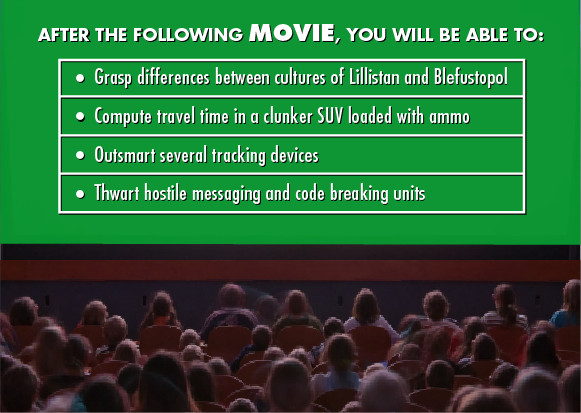
You can’t wait to see what happens next. NOT! When you’re spending time in front of a movie screen, you deserve to be intrigued, mystified, frightened, made to laugh, or … engaged and drawn in, in some way. You don’t expect a bullet point list of the movie’s objectives. So why is it not only acceptable, but also, at times “required,” to begin with objectives like these in elearning courses? We’ve all heard these responses:
- “Learners need to know what to focus on in the training.” (True, but when presented with a bullet point list, even motivated learners skim the list, comprehending little before they click “Next”. As for the unmotivated learners … they’re simply itching to click “Next” as quickly as possible and move on! )
- “We must ensure learners know what will be on the test.” (Fair enough, if there is a test, but does reading a bulleted list accomplish that?)
- “That’s just good instructional design!” (Really? Why?)
Aren’t learners entitled to content that grabs their attention, involves them in the action, and engages their imagination and desire to do well? No matter how fantastic the design of the course is, if the first 30–45 seconds of the experience don’t pull learners in, we’ve lost them before they’ve even started!
Are There Alternatives?
What are some alternatives to a tedious bulleted list of terminal objectives at the beginning of a course? What’s needed are some creative and effective ways to start an elearning experience. Here are some ideas:
- Grab their attention with a story, humor or drama.
- Hit them with surprising and compelling facts that can motivate the learner to see what happens next.
- Put them to work!
Tell a Story
Everyone is concerned about the welfare and safety of children. Yet abuse still takes place. Children die from preventable injuries and violence, had the adults around them taken action. In a course designed to help learners spot problems and take actions that could help children who may be in abusive situations, three real stories of child abuse are presented as front page newspaper articles on the second page of the course.
The learner is asked to read each story. They are quite painful; by the end of the third story the learner should feel disturbed, and motivated to make a difference.
A compelling story (or three) personalizes the introduction to your elearning course and touches the learner’s emotions. Begin with a story that paints a picture of the situation that needs to be transformed. Make it graphic and real. Use the story to provide examples throughout the presentation of the content. Build suspense, and your learner will want to find out what happens next.
You might think, “That’s great for a course on child safety, which lends itself easily to dramatic stories, but what about my boring compliance course?” Actually, most performance issues worthy of an elearning course could be topics for a dramatic story. Think about the consequences of people not doing the right thing at the right time and then build a story around that. If you want a realistic story, you can do a Google search for situations where other organizations have run into trouble by not doing things right. For example, if you’re creating a course on data protection (yawn!), a quick Google search reveals that after a data breach, Target Corp faced angry customers, lawsuits, and a declining stock price. These articles could be woven into an attention grabbing story.
Make Them Smile
A large corporation would like its employees to behave in a way that respects co-workers within their cube farm. They create a mandatory elearning course and tell every employee to complete it by the end of the month. Employees don’t care, just another corporate hoop to jump through. Which of the following introductions will pique the learners’ interest?
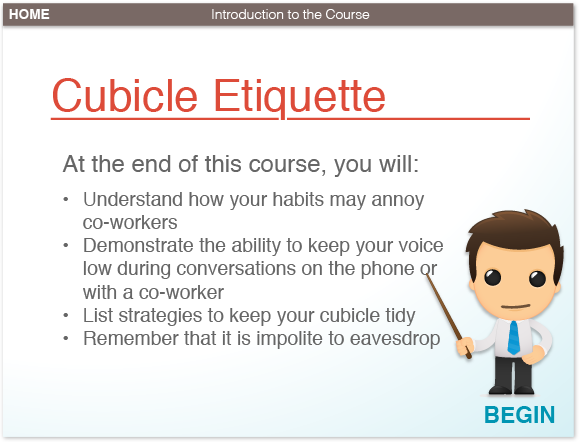
Or…a narrator appears and asks, “Psst, how would you feel about being on the receiving end of one of these notices?”
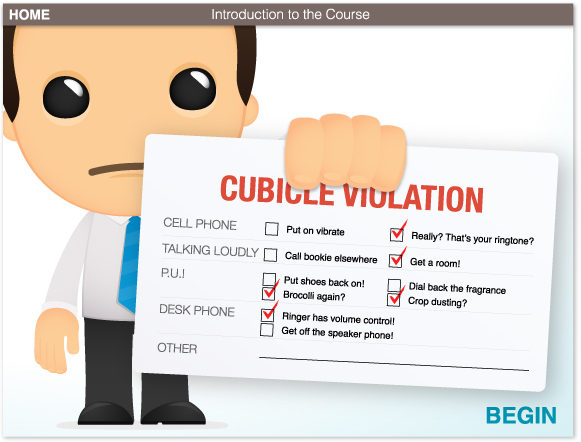
The cubicle violation notice makes them laugh, and immediately they understand why they need to finish the course, and are drawn to do so. Keep them laughing, and the content will stick.
Shock and Compel
Older high-school juniors and seniors may think that being a lifeguard is fun. But it’s not all cool sunglasses and hot suntans. Y-USA engaged SmartBuilder to develop a multi-module elearning experience to be used in conjunction with “in the pool” lifeguard training. The first module is an introduction to the responsibilities of lifeguarding, and it’s critical that future lifeguards “grok” the serious nature of the job.
When the stakes are high, you may want to jolt your audience by uncovering somber statistics and putting a human face on them. This lifeguard course opens with grim music playing while shocking statistics about drowning deaths and injuries appear out of a black cloud. The future lifeguard is given a moment to ponder the heavy responsibility and is then asked “Are you ready …?”
Put Them to Work!
When you ask a learner to complete a task at the start of a course, they will be pleasantly surprised (“Wow, I already get to DO something!”) and are more likely to pay attention.
When used as part of an introduction, the purpose of an activity is different than later on in a course. Later on, you are typically trying to build skills and/or change behaviors. In an introduction, the goal of the activity, besides grabbing your learners’ attention, might be to:
- Demonstrate that the topic is important.
- Foreshadow what will come later.
- Demonstrate that the learner doesn’t “already know it all”.
- Show consequences of poor performance.
Click the play button below for a great example of putting the learner to work.
Conclusion
When designing elearning, you’ll first determine performance and knowledge objectives, and probably work with a number of lists! But when it’s time to make a connection with the learner, leave the lists behind. Involve them with a story, try a humorous slant, dramatize and put them on the edge of their seats, or put them to work. Test a few different introduction styles on representative learners and gauge which is most effective at grabbing their attention.
We’re interested in hearing from you! What strategies for immediately engaging your learners’ have worked for you? Do you have any stories of strategies that didn’t go over so well? Leave your comment below.
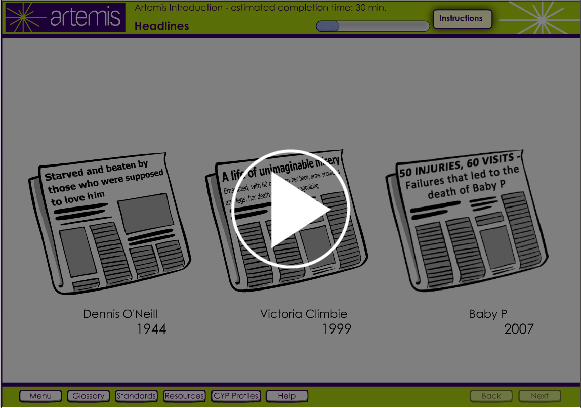
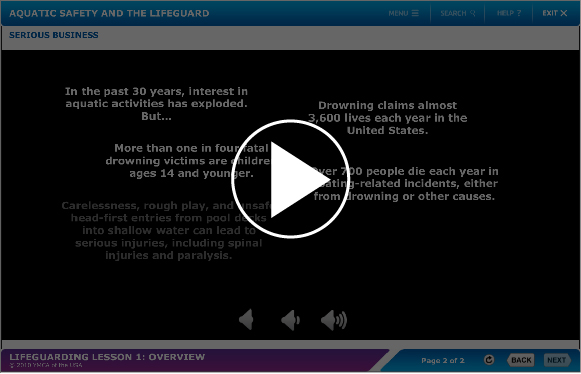

Nice article! These are all great ideas to engage the learner at the beginning. Thanks for sharing!
Excellent article! I loved the way you presented it by the piece on objectives of a movie! In fact, it validates the message of the article. The enemy of better introductions is what is called standardization. Creating standardized courses inevitably tends to make the process easier for IDs and therefore, mediocre. If each course were to be given attention, then having a list of objectives at the beginning will not be a given. And, then for this, we need passion to imagine great introductions! You have made a beginning. Lets see where it takes us.